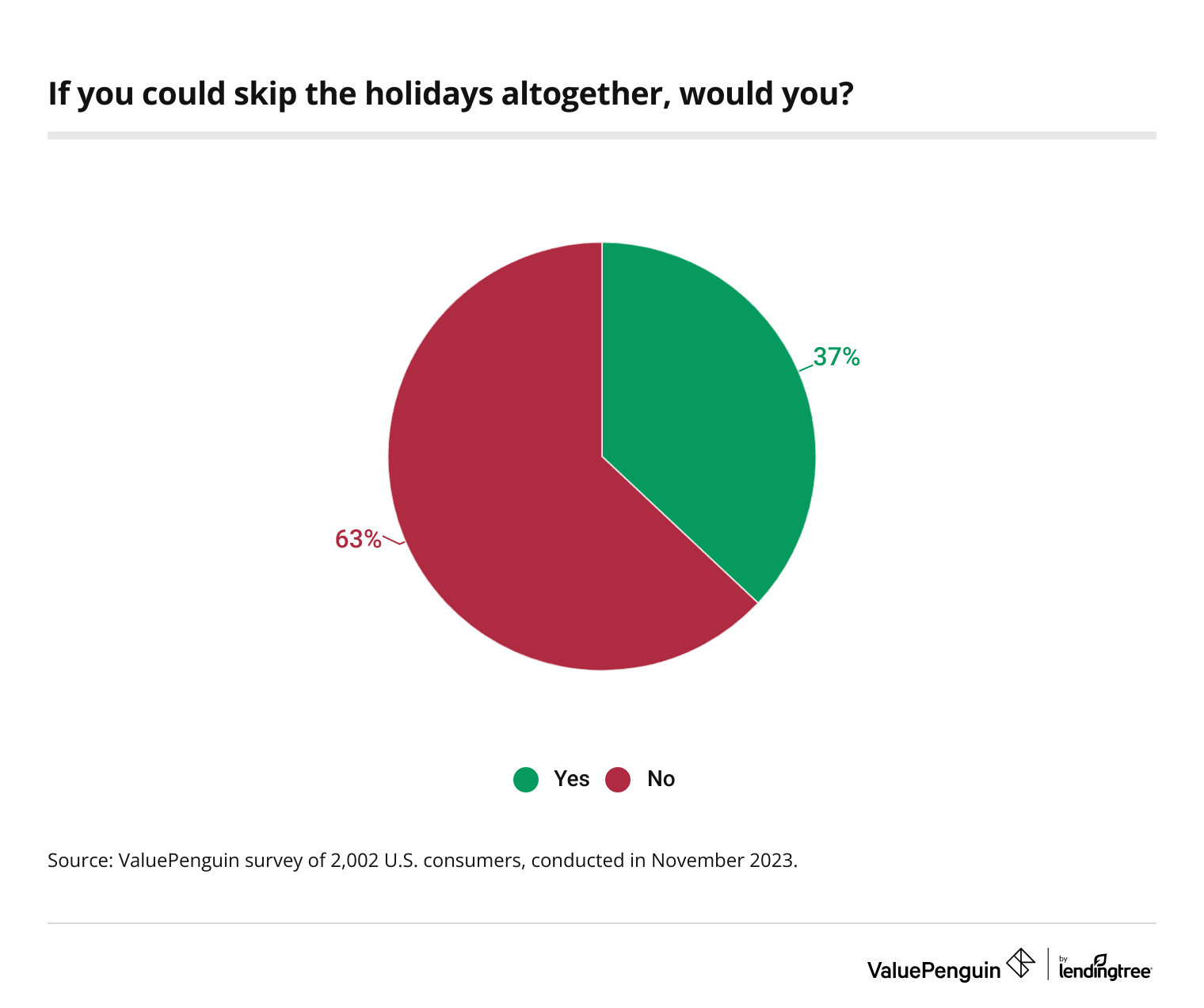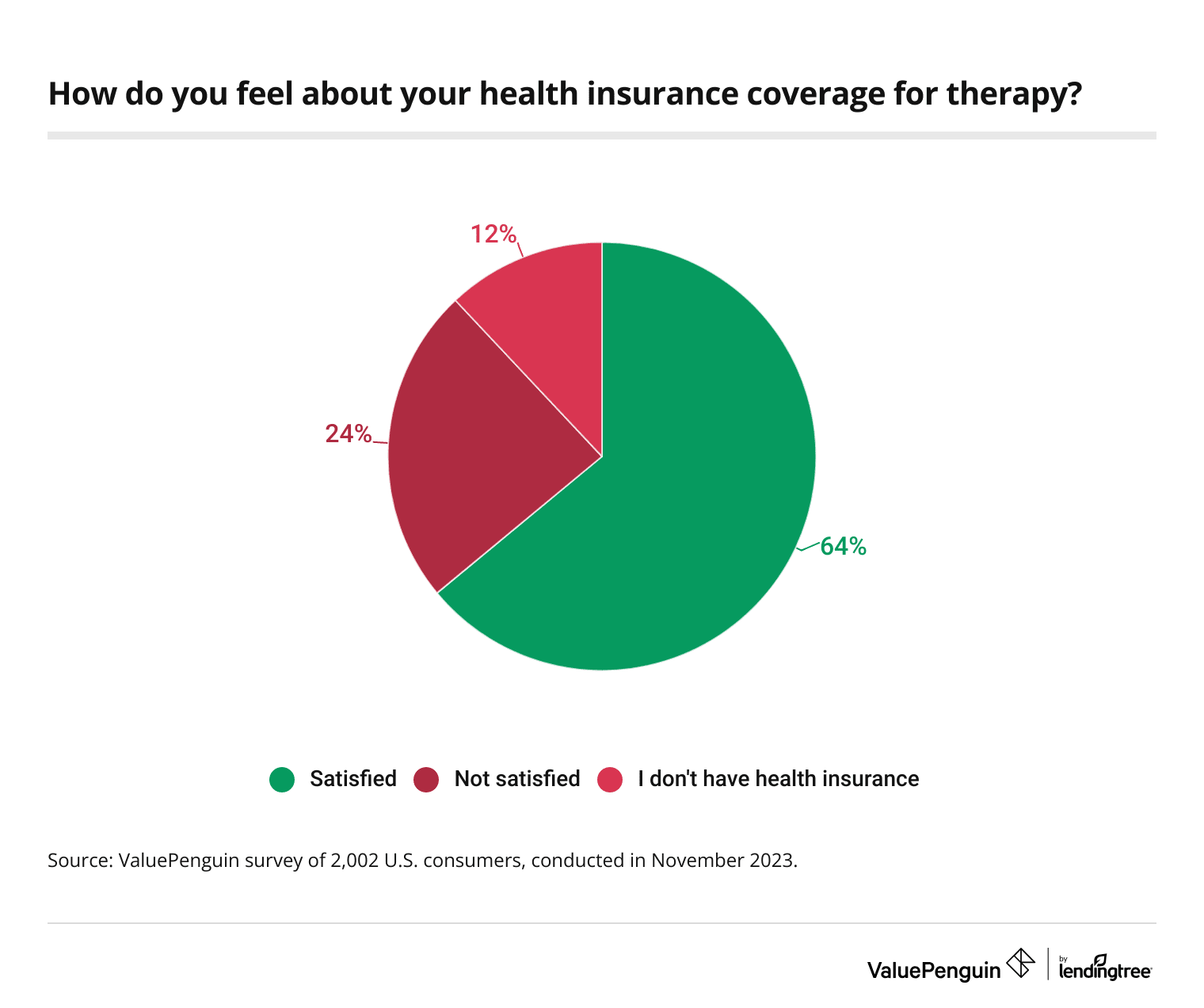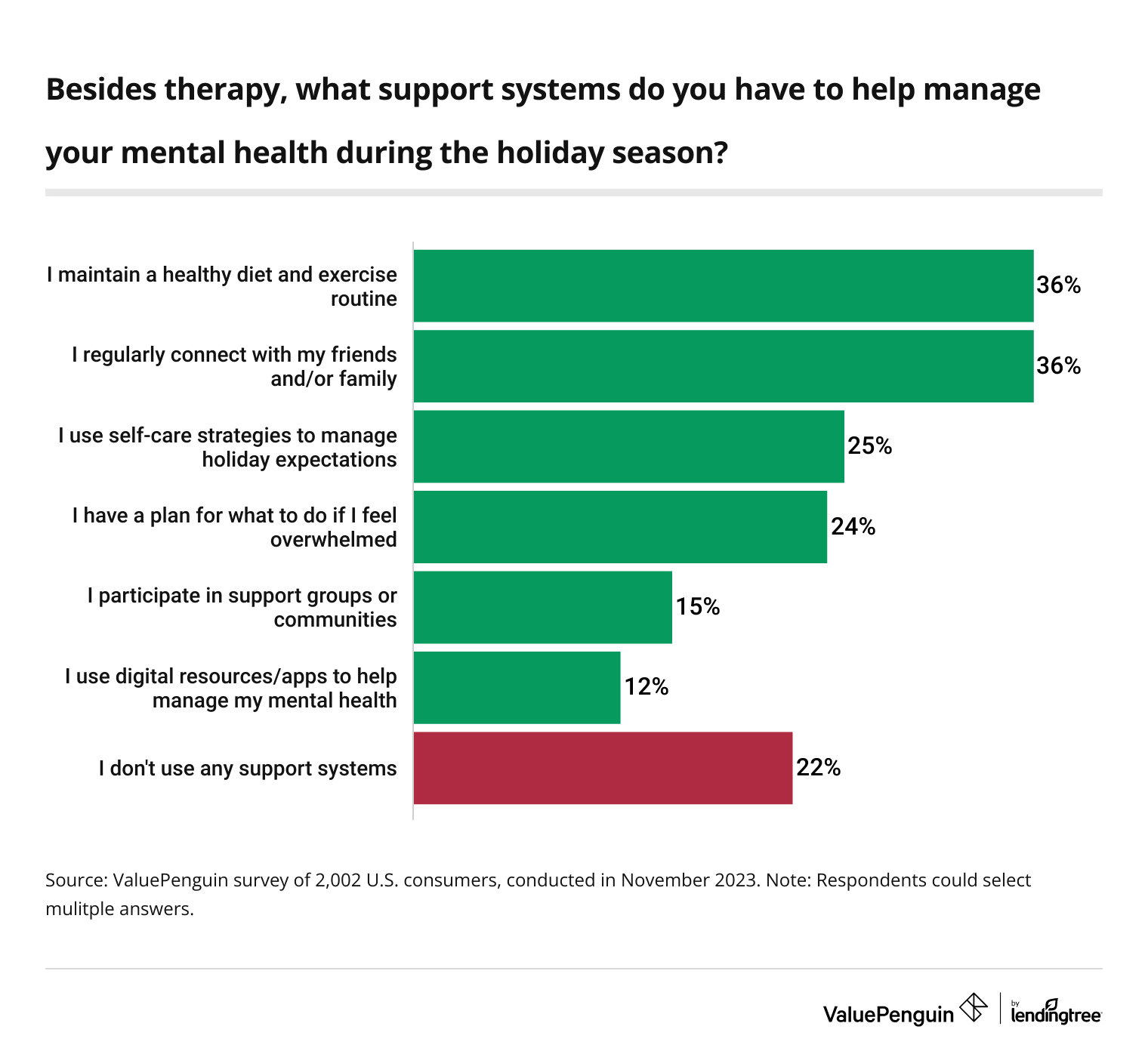Health Insurance
61% of Americans Will Feel Sad or Lonely This Holiday Season, and 37% Wish They Could Skip It Altogether

'Tis the season for holiday cheer, but many Americans may expect the opposite.
According to the latest ValuePenguin survey of over 2,000 U.S. consumers, 61% think they’ll experience feelings of loneliness or sadness and 67% expect to feel anxious or stressed during the holidays this year.
We unwrap which demographics struggle the most with holiday blues, which coping mechanisms struggling Americans rely on most and who’s most likely to consider therapy. Additionally, stick around for tips on finding affordable therapy options.
On this page
- Key findings
- Majority of Americans expect to feel holiday blues
- 37% would skip the holidays if they could
- For many, therapy offers respite this holiday season
- Transforming ‘bah humbug’ into ‘ho-ho-hope’: How Americans are coping with the holidays
- Overcoming financial hurdles to therapy: Top expert tips
- Methodology
Key findings
- The holiday blues are just around the corner. This holiday season, 61% of Americans think they’ll experience feelings of loneliness or sadness — an increase from 55% in 2021. Additionally, 67% expect to feel anxious or stressed during the season. Among those struggling with the holidays, 67% say it's due partly to societal or cultural expectations and 49% say they don’t believe others acknowledge their feelings.
- Many Americans wish they could fast-forward through the "most wonderful time of the year," and others rely on substances to do that. In fact, 37% of Americans say they would skip the holidays altogether if they could. Some Americans are self-medicating to get through it, with 22% reporting they grapple with substance abuse over the holidays. When asked why, 29% say they’re more likely to party during this time of year and 28% say it’s because they’re more depressed.
- Some are turning to therapy to help them navigate the season. Across all Americans, 44% have looked into seeing a therapist in the past year, with Gen Zers (66%) and millennials (58%) leading the way among the age groups. Most Americans (64%) are satisfied with their health insurance’s coverage for therapy. However, the 24% who are unsatisfied would prefer lower copays (58%), being in-network with more providers (34%) and better coverage for virtual sessions (33%).
- Staying active and cutting back on social media are helping Americans get through the holidays. Other than utilizing therapy to help manage their mental health during the holidays, the most popular support systems are maintaining a healthy diet and exercise routine (36%) and regularly connecting with friends and/or family (36%). Additionally, 53% of Americans say they at least plan to cut back on their social media over the holidays.
Majority of Americans expect to feel holiday blues
Though Santa’s on his way, most Americans expect a visit from the Grinch this year. As the holiday season approaches, 61% of Americans think they’ll experience feelings of loneliness or sadness. That’s an increase from 55% in 2021, when we last conducted this survey. This comes as nearly a quarter (24%) of this year’s respondents say they’ll feel more lonely or sad this year than last year.
By age group, Gen Zers ages 18 to 26 are the most likely to expect the holiday blues, at 73%. That’s followed by:
- Millennials ages 27 to 42 (65%)
- Gen Xers ages 43 to 58 (64%)
- Baby boomers ages 59 to 77 (45%)
Those with kids younger than 18 (69%) are more likely to expect feelings of sadness or loneliness than those without children (61%) and those with children older than 18 (52%). Additionally, women (63%) are more likely to share this sentiment than men (58%).
When asked what’s contributing to these feelings, 43% of those expecting the holiday blues say they’re grieving the loss of a loved one — the most common response. Following that, 39% say not being around loved ones contributes to their holiday blues and 37% struggle with seasonal depression. Other causes of holiday sadness or loneliness are:
- Financial struggles (33%)
- Seeing family (24%)
- Social media (22%)
- Poor relationships with family (22%)
- Others celebrating holiday engagements (16%)
- Anxiety about the COVID-19 pandemic, new variants or other illnesses (12%)
- Struggles with infertility (6%)
- Other (5%)
While the increase in the rate of Americans experiencing loneliness and sadness over the holidays doesn’t surprise ValuePenguin health insurance expert Divya Sangameshwar, the steepness of the increase does.
"Across all age groups, people are spending less time with each other in person, and elements of technology (like social media) have us maximizing the amount of time we spend online — often at the expense of our in-person interactions," she says. "It isn’t surprising that so many of us feel lonely even with a lot of people around us, but that big jump between 2021 and 2023 could be attributed to new stressors — like moving due to back-to-office mandates, job loss and the rising cost of living."
It’s not just the blues affecting Americans during the season of holiday cheer. In fact, 67% expect to feel anxious or stressed during the holidays. Those with children younger than 18 (79%) are the most likely to expect these feelings, followed by Gen Zers (76%), millennials (74%) and those earning between $50,000 and $74,999 (72%). Women (70%) are more likely to expect feelings of anxiousness and stress than men (64%).
What contributes to these feelings? Among this group, 38% attribute financial struggles to their holiday anxiety or stress. Following that, grieving the loss of a loved one (35%) and seasonal depression (31%) are the other top reasons for anxiety or stress. Other responses include:
- Not being around loved ones (30%)
- Seeing family (26%)
- Poor relationships with family (21%)
- Social media (16%)
- Others celebrating holiday engagements (16%)
- Anxiety about the COVID-19 pandemic, new variants or other illnesses (13%)
- Other (7%)
- Struggles with infertility (6%)
Regardless of whether they expect to struggle with feelings of sadness, loneliness, anxiety or stress, 67% of those affected by the holiday say their feelings are due partly to societal or cultural expectations. That’s especially true among Gen Zers (74%), those with children younger than 18 (72%) and millennials (71%).
Meanwhile, 49% of this group say they don’t believe their feelings are acknowledged by others, led by Gen Xers (58%), those making less than $35,000 a year (54%) and those without children (54%). Notably, women (53%) are significantly more likely to say this than men (44%).
37% would skip the holidays if they could
With many Americans struggling to cope during the holiday season, it may not be surprising that some wish they didn’t hear sleigh bells ringing. Across all Americans, nearly 2 in 5 (37%) say they would skip the holidays altogether if they could. Those earning between $35,000 and $49,999 (42%), divorced Americans (42%) and those with children younger than 18 (41%) are the most likely to feel this way.
By age group, Gen Xers (41%) are the most likely to say they’d skip the holidays if they could, followed by millennials (40%).

On the other hand, some Americans are ensuring the holidays are a blur by self-medicating. Across all Americans, 22% grapple with substance abuse over the holidays, leading with Gen Zers (37%), those with children younger than 18 (35%) and millennials (32%). Men (28%) are much more likely to struggle with substances during the holidays than women (17%).
When asked why they struggle with substances, 29% say they’re more likely to party during this time of year — the most common response. Not far behind, 28% say it’s because they’re more depressed. Other responses include:
- Feeling pressure from family and friends (13%)
- Using substances as a coping mechanism for holiday stress (11%)
- Using substances to deal with grief or loss, which feels more intense during the holidays (6%)
- Feeling increasing isolation and loneliness during the holidays (6%)
- Using substances to escape from family conflicts or tension that arise during holiday gatherings (5%)
- Other (2%)
For many, therapy offers respite this holiday season
Mistletoe may bring kisses, but therapy can bring mental blissmas — at least for the 44% of Americans who’ve looked into seeing a therapist in the past year. To break that down:
- 15% have looked into seeing a therapist but haven’t signed up or seen one
- 14% are currently seeing a therapist
- 11% saw a therapist in the past year but are no longer doing so
- 4% have signed up to see a therapist during this holiday season
Gen Zers (66%), those with children younger than 18 (61%) and millennials (58%) are the most likely to have looked into seeing a therapist in the past year.
These demographics are generally the same ones who’ve been most interested in therapy in the past. According to an early 2023 ValuePenguin survey on seeking therapy, Gen Zers, those with children younger than 18 and millennials were among the most likely to have seen a therapist at least once since March 2020 — the start of the pandemic.
Regardless of whether they’re exploring therapy, 64% of Americans are satisfied with their health insurance’s coverage for therapy.

Among the 24% who are unsatisfied, 58% prefer lower copays — the most common response. Following that, 34% wish they had more in-network providers and 33% wish they had better coverage for virtual sessions.
With such a high rate of Americans struggling to cope with the holidays, Sangameshwar encourages more Americans to explore therapy.
"Experiencing low spirits during a time celebrated for its happiness can intensify negative feelings about yourself," she says. "You might feel ungrateful, disrespectful, unappreciative or believe something is ‘wrong’ with you. Expressing those feelings in conversation with a therapist will help you to understand that what you’re going through isn’t something to be swept under the rug, and that those feelings are valid. A therapist will also give you the tools and strategies to cope with your holiday stressors."
Transforming ‘bah humbug’ into ‘ho-ho-hope’: How Americans are coping with the holidays
Of course, therapy isn’t the only way Americans can improve their mental state during the holiday season. To help manage their mental health during this time of year, 36% of Americans say they’re actively maintaining a healthy diet and exercise routine, tying with regularly connecting with friends and/or family (36%) as the most popular support methods.

Sangameshwar says having a support plan is crucial this time of year — regardless of whether you struggle with the season.
"Healthy habits like these serve as a reminder to everyone struggling with holiday stress and loneliness to embrace the ‘me’ in merry and put their own mental and physical well-being first," she says. "Even with a busier schedule than usual, making room for self-care (such as taking a walk, listening to music or indulging in a relaxing bath) can be your best defense against feeling overwhelmed and be the key to enjoying the holiday season."
Separately, 53% say they at least plan to cut back on their social media over the holidays. And 19% plan to get off social media entirely for a bit. Overall, those with children younger than 18 (66%), Gen Zers (65%) and millennials (63%) are the most likely to at least cut back.
Overcoming financial hurdles to therapy: Top expert tips
It’s common to struggle with negative feelings during the holiday season, but therapy may offer some support. For those considering therapy but struggling to afford it, Sangameshwar offers the following advice:
- Talk to your health insurance provider about their network of therapists and mental health care facilities. If you feel that your coverage is inadequate, take advantage of open enrollment (which ends Jan. 15) to get a new health plan that’ll cover your therapy sessions.
- Ask for alternative pay options. "If you have no room to negotiate with your insurer or have no extra money to sign up for an insurance plan with better coverage, you can ask your therapist (or potential therapist) about sliding-scale payment options," Sangameshwar says. "This uses your income level to determine the cost of therapy."
-
Look into local community-based clinics that offer free or low-cost mental health services. "Nonprofits like the National Alliance on Mental Illness (NAMI) and Mental Health America (MHA) can also connect you with low-cost or free mental health facilities," she says. "Your nearest university hospitals or medical schools may also have programs that give you access to therapists in training for free or at a low cost.
Methodology
ValuePenguin commissioned QuestionPro to conduct an online survey of 2,002 U.S. consumers ages 18 to 77 from Nov. 6 to 9, 2023. The survey was administered using a nonprobability-based sample, and quotas were used to ensure the sample base represented the overall population. Researchers reviewed all responses for quality control.
We defined generations as the following ages in 2023:
- Generation Z: 18 to 26
- Millennial: 27 to 42
- Generation X: 43 to 58
- Baby boomer: 59 to 77